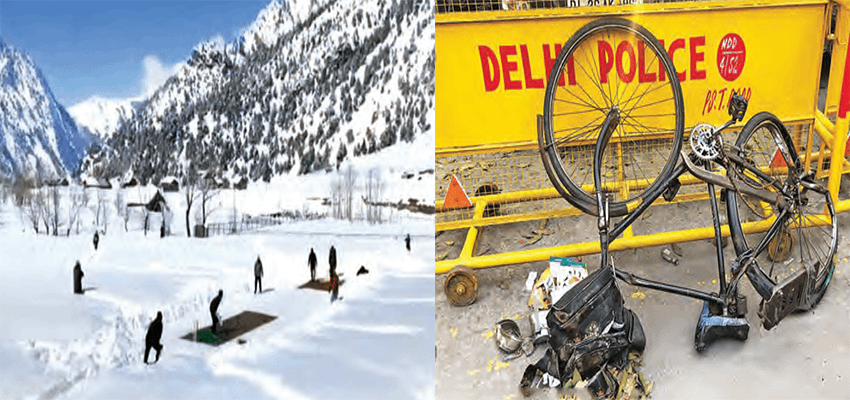
Corporate Citizen claps for the Indian Army’s initiatives keeping youngsters pepped up in the ex- treme climes across Drass (Kargil district in Ladakh) and Gurez, a valley located 123 kilometers (76 mi) from Srinagar to the north of the Kashmir valley.
The harsh weather in the picturesque snow-capped ranges caus- es people to remain cut off from the mainland for months and with little scope for productive occupations. Particularly, the snow-clad areas around Gurez, located near the Line of Control (LoC) remain cut off from Srinagar for months due to snowfall. The Indian Army’s proactive stance in arranging sporting encounters enhanced the happiness quotient of people in the region. The Army has since organized a regional ice hockey tournament and archery competition at Bimbat, in Drass, one of the coldest places in the world, often remaining isolated due to bad weather. Around 12 teams encompassing male athletes and three teams of female athletes participated in the ice hockey tournament. Around 100 archers from the surrounding villages participated in the archery skill competition. A day-long ski camp in Drass saw participation from locals and international skiers. The slopes and snow quality in the region have prompted the government to promote winter sports in these areas too. According to organisers, the festival has garnered interest from around 300 youngsters and is seen as a moment for the locals of the area who do not have much to do during the harsh winter months. “All team mem- bers played a great role in making these sports activities a success. We want youngsters to stay away from drugs and vices, and involve themselves in sports. I request the administration to organise more such activities, especially snow sports,’’ said an organiser. According to Maj K Sreeram Renjith, via https://www.radiochinar.in/, the Indian Army has the wherewithal under Operation Sadhbhavana, to promote winter sports and conduct enrolment programs in the far-flung areas of Kashmir and Ladakh. “Individuals from units deployed in the valley can be trained at High Altitude Warfare School(HAWS) as instructors in various disciplines of winter sports and micro-training facilities can be opened in COBs to identify and train aspiring athletes”, said Major Renjith.
Corporate Citizen slaps the lack of infrastructure in encouraging cy- cling as a safe mode of transport, especially on Delhi’s roads.
A recent IIT-Delhi study concluded that cyclists are 40 times more prone to fatalities than cars in Delhi. The study estimates that in Delhi, each year, cyclists travel an average of 2.5 billion kilometers (bkm) while the total distance covered by all cars is 48.8 bkm and 41.39 bkm for motor- cycles. On November 22, Delhi-based cyclists united in protests following the fatal accident of Suvendu Banerjee, a 50-year-old businessman and cyclist, who despite wearing a helmet, was hit by a car from behind. Cycling in Delhi, whether for a hobby or initiating environment-friendly stakes, has been the death knell. It is especially so for those using cycles as their only mode of transport. The low-cost element in sustaining a cycle and affordability is the only choice for several blue collared workers, covering an average of around 10 kilometers as part of their daily commute. Most can ill afford bus services as the monthly costs of bus rides would easily eat away 30% of their hard-earned salary. Besides, lack of safety or absence of guidelines or designated cycle routes poses injury issues on expressways and lanes. The IIT-Delhi study covered 72 locations, including Tughlakabad, Guru Ravidas Marg, Mathura Road, Outer Ring Road, Lodhi Road, and Mahatma Gandhi Road, among others, and examined the risks cyclists face in Delhi. It noted that, on average, 52 cyclists died every year between 2017-2019, on Delhi roads. For motorcyclists, this number was 541, and for car occupants, it was 52.6. Based on the data, the study calculated the fatality risk by dividing them by the annual person kilometers traveled (PKT) for each vehicle type. According to Rahul Goel, Assistant Professor at Transportation Research, and Injury Prevention Centre (TRIP Centre) IIT-Delhi, and a key researcher, observed that the dearth of data poses a significant challenge when planning cities for cycling. He said that “Most planning for facilities for cyclists is likely to be ad hoc and not backed by required data. With the severity of air pollution in India, particularly in Delhi, it is estimated that the increased use of cycles can reduce carbon emissions and Particulate Matter (PM) 2.5 exposure.” It is a cry once again to save the environment, and the lives of seasoned cyclists, and frugal breadwinners; slapping strict guidelines and penalties on those who do not respect the road space of the humble cyclist!